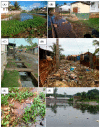Urbanization and Waterborne Pathogen Emergence in Low-Income Countries: Where and How to Conduct Surveys?
- PMID: 31940838
- PMCID: PMC7013806
- DOI: 10.3390/ijerph17020480
Urbanization and Waterborne Pathogen Emergence in Low-Income Countries: Where and How to Conduct Surveys?
Abstract
A major forthcoming sanitary issue concerns the apparition and spreading of drug-resistant microorganisms, potentially threatening millions of humans. In low-income countries, polluted urban runoff and open sewage channels are major sources of microbes. These microbes join natural microbial communities in aquatic ecosystems already impacted by various chemicals, including antibiotics. These composite microbial communities must adapt to survive in such hostile conditions, sometimes promoting the selection of antibiotic-resistant microbial strains by gene transfer. The low probability of exchanges between planktonic microorganisms within the water column may be significantly improved if their contact was facilitated by particular meeting places. This could be specifically the case within biofilms that develop on the surface of the myriads of floating macroplastics increasingly polluting urban tropical surface waters. Moreover, as uncultivable bacterial strains could be involved, analyses of the microbial communities in their whole have to be performed. This means that new-omic technologies must be routinely implemented in low- and middle-income countries to detect the appearance of resistance genes in microbial ecosystems, especially when considering the new 'plastic context.' We summarize the related current knowledge in this short review paper to anticipate new strategies for monitoring and surveying microbial communities.
Keywords: drug resistance; metagenomic; plastics; surface water; urbanization; waterborne diseases.
Conflict of interest statement
The authors declare no conflict of interest.
Figures
References
-
- Christopher C., Estol-Peixoto R., Hartjes E., Rampton A., Ritger P., Waukau H. Urban Environments in Low-Income and Lower Middle-Income Countries: Policy Performance Indicators at the Subnational Level. La Follette School of Public Affairs, University of Wisconsin; Madison, WI, USA: 2012.
-
- UNICEF . Progress on Drinking Water, Sanitation and Hygiene: 2017; Update and SDG Baselines. World Health Organization (WHO) and the United Nations Children’s Fund (UNICEF); Geneva, Switzerland: 2017.
-
- United Nations . World Urbanization Prospects, the 2015 Revision. United Nations Department of Economics and Social Affairs, Population Division; New York, NY, USA: 2015.
-
- Bastaraud A., Rakotondramanga J.M., Mahazosaotra J., Ravaonindrina N., Jambou R. Environmental threats impacts on drinking-water microbial quality in low-income urban water supplies, Case of Madagascar. Waters. 2018;10:1450. doi: 10.3390/w10101450. - DOI
-
- Jamwal P., Mittal A., Mouchel J. Point and non-point microbial source pollution: A case study of Delhi. Phys. Chem. Earth Parts A/B/C. 2011;36:490–499. doi: 10.1016/j.pce.2008.09.005. - DOI
Publication types
MeSH terms
Substances
LinkOut - more resources
Full Text Sources
Medical


